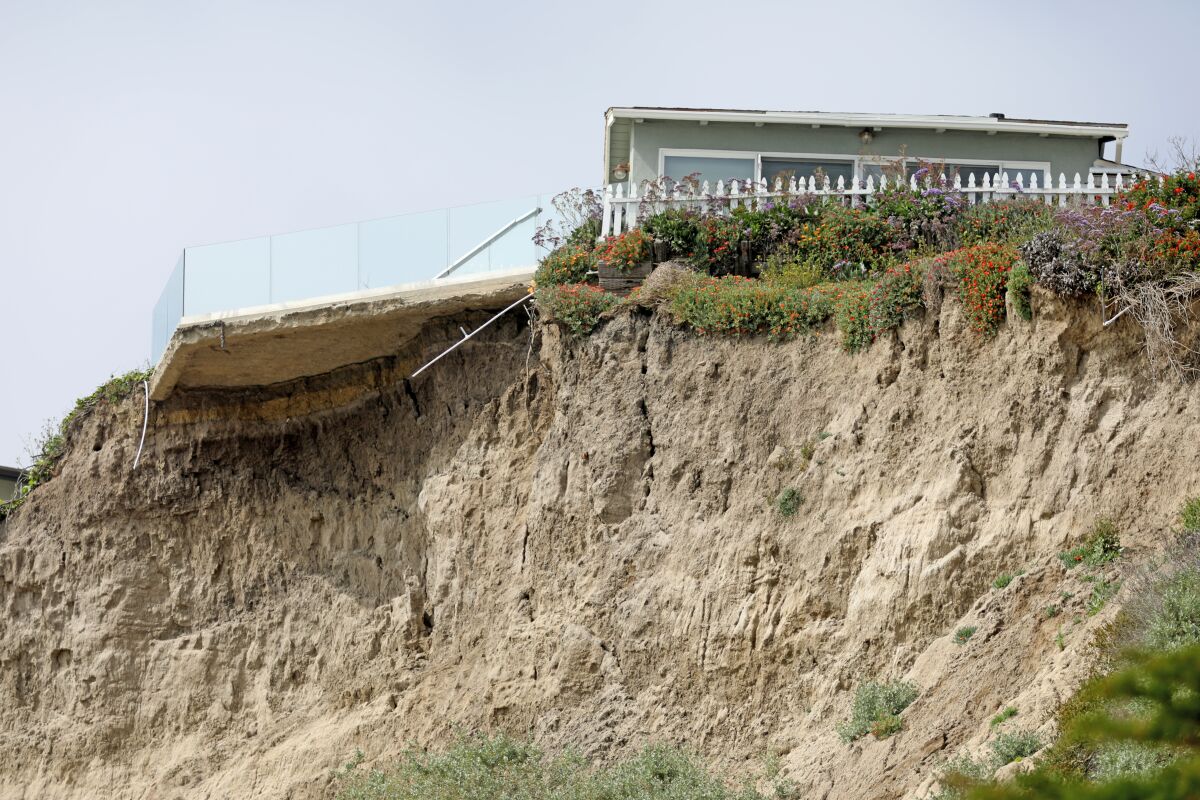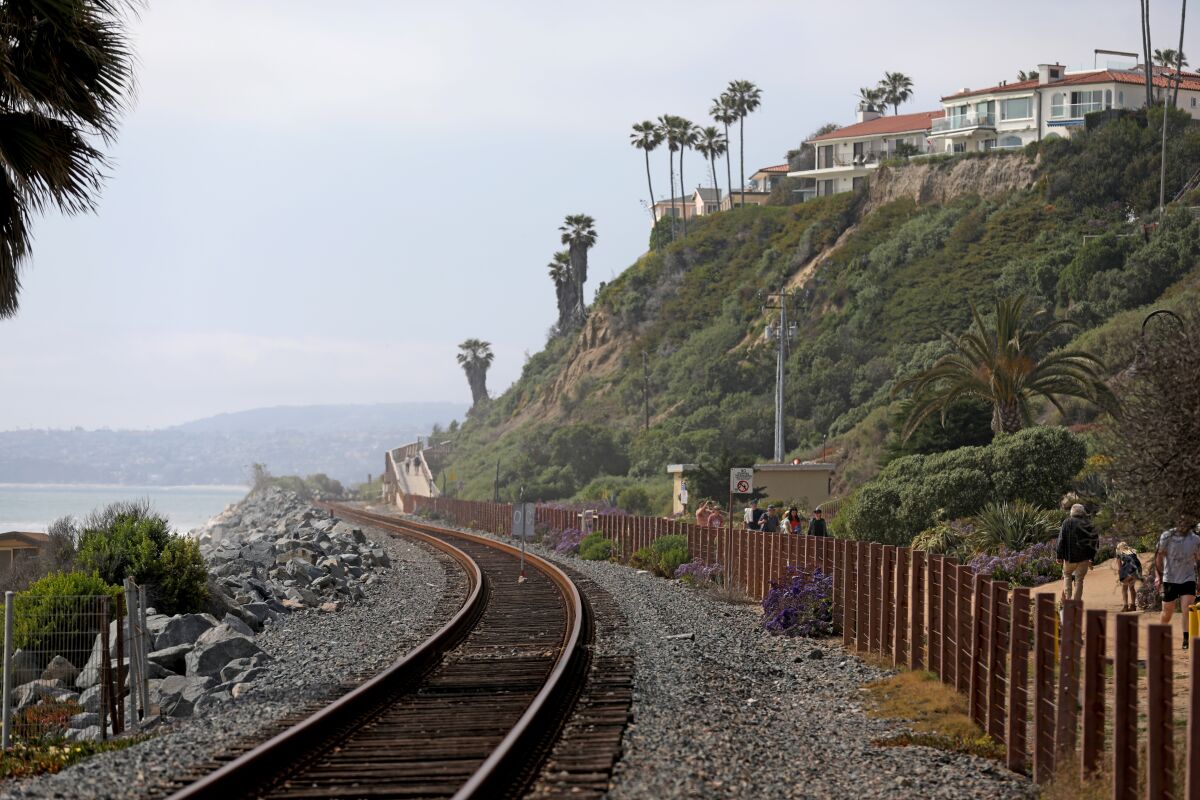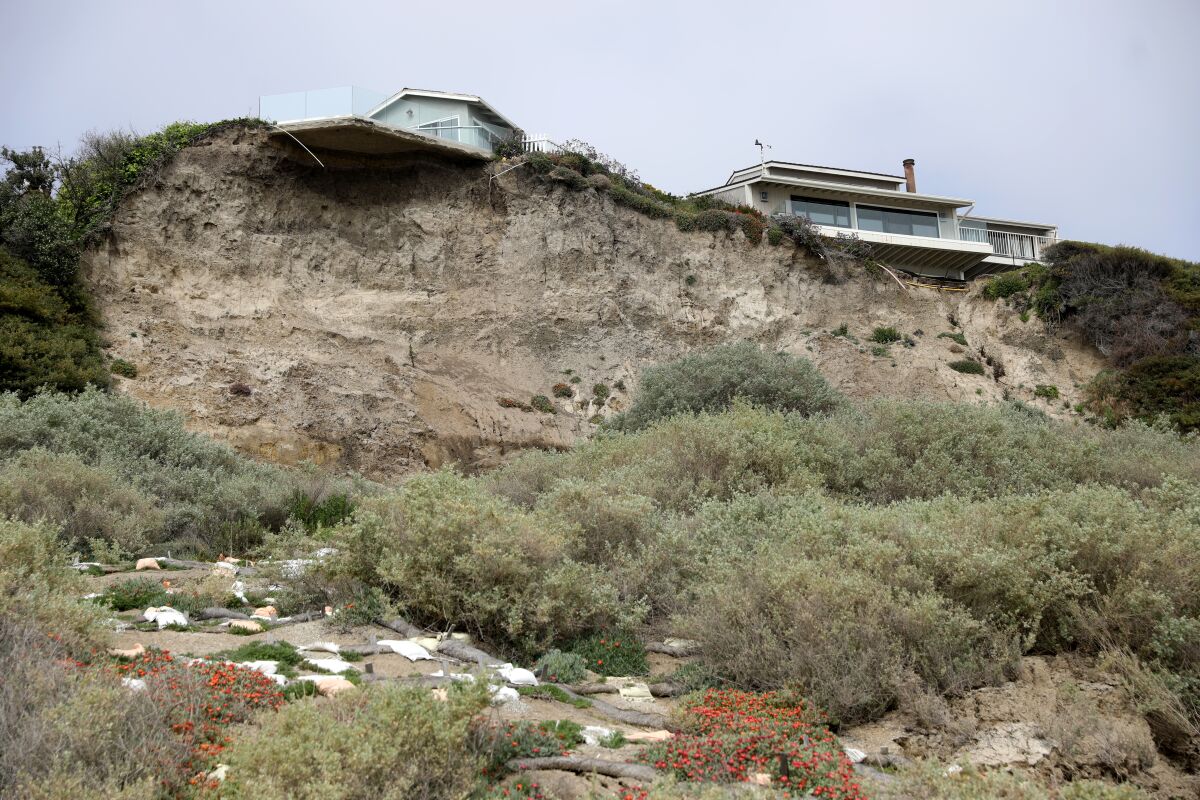On a rather cool spring day in late April, Amy Behrens was strolling through the manicured grounds of Casa Romantica, a historic San Clemente landmark known for its panoramic ocean view, when she heard a low rumble.
As she looked on in shock, a portion of the steep sandstone cliff underlying the cultural center crumbled toward the beach below, dragging with it portions of Casa Romantica’s iconic ocean terrace and resplendent walkways planted in bright coastal flora.
“I watched the bluff erode right in front of my eyes,” said Behrens, executive director of the nonprofit group that operates Casa Romantica.
A crack first discovered on the terrace April 16 had prompted a decision to cordon off the area while the city contracted with geotechnical engineers for a $75,000 study of soil movement on the bluff. The landslide followed 11 days later and left the terrace — a sought-after wedding venue — and portions of the coastline below red-tagged.

Erosion of Orange County’s ocean bluffs, exacerbated by an unusually wet winter, have put several homes at risk.
(Gary Coronado / Los Angeles Times)
The Casa Romantica landslide is the latest in a season of crumbling cliffs in California following a winter of remarkably wet and powerful storms. More than 700 landslides were reported statewide in January alone, according to the California Geological Survey.
In Orange County, instability in the saturated coastal cliffs has caused an estimated $26 million in damage to public and private property since December.
In March, a Newport Beach home overlooking the water was demolished after a landslide. Later that month, a landslide in San Clemente prompted evacuation of four oceanfront apartment buildings. Laguna Niguel declared a local emergency last week after soil movement was detected beneath the hilly contours of La Paz Road, prompting officials to close two lanes indefinitely.
On May 9, the Orange County Board of Supervisors extended its own emergency declaration through late June in light of the recent incidents and are hoping to tap into federal disaster relief funds to repair damage and fortify the vulnerable slopes.
For San Clemente, the damage to Casa Romantica has been a particularly difficult blow.
The 2.5-acre property was once the home of San Clemente’s founder, Ole Hanson, who built his Spanish Colonial Revival-style home in 1927. It passed through various owners and uses until the 1980s, when San Clemente’s redevelopment agency took control and the property was declared a registered historic trademark. Several years later, a $1-million gift from an anonymous donor set its course as a cultural center celebrating arts and horticulture.
Over the years, the center’s graceful archways and whitewashed walls have become a favorite for both art shows and wedding planners. Private rentals for weddings — booking a Saturday night in peak season runs about $8,000 — and other events have accounted for roughly a quarter of the nonprofit’s funding in recent years.
On the advice of city officials, Casa Romantica remains closed to visitors. Multiple couples have canceled their summer wedding dates and are slated to receive refunds.
“We’re really going to have to rely on contributions and grants to sustain us,” Behrens said. “We’ll have to work that much harder to find the revenue sources to help us move through this.”
And the impact of the landslide resonates beyond canceled weddings.

The landslide at Casa Romantica in San Clemente has interrupted service on a popular passenger railway that weaves along the base of the bluffs.
(Gary Coronado / Los Angeles Times)
The slope failure sent debris hurtling onto train tracks on the beach below and brought passenger rail service to a halt. That was just two weeks after passenger service had been restored following a six-month, $1.5-million effort to stabilize the sand beneath the tracks.
That effort was meant to address San Clemente’s other environmental conundrum: beach erosion. While Orange County is known for the wide swaths of beach that front the coastline in areas such as Newport Beach, the beaches along San Clemente are relatively narrow and subject to tidal erosion that had caused the tracks to move.
After the landslide, both passenger and freight service were halted. Freight trains have resumed traveling at a 10 mph crawl past Casa Romantica, but Metrolink and Amtrak passenger services remain suspended.
Rep. Mike Levin, a Democrat whose district takes in southern Orange County, called San Clemente’s tracks one of the “weakest links” in a rail corridor that connects San Luis Obispo, Los Angeles and San Diego and hosts 8 million riders annually.
“We rely very heavily on beach tourism and recreation,” Levin said. “Rather than putting Band-Aids on this every year, I want to think long-term about how we ensure the rail corridor is up and running for decades and centuries to come.”
Indeed, restaurants and tourist shops along San Clemente’s pier are feeling the financial effects of the dual hits on Casa Romantica and regional rail service.
Josie Rietkerk owns Caterina’s Gelato Bar and relies on Metrolink’s weekend service to deliver foot traffic to the beach, especially from the Inland Empire.
“The Weekender brings in 300 to 500 people on Saturday and another 300 to 500 people on Sunday,” said Rietkerk. “We probably drop about $1,000 in sales every time the train does not come through.”
Mark Esparza is director of operations at Fisherman’s Restaurant and Bar at the base of the pier. The weekend before the landslide, big crowds emptied out of trains, thrilled that passenger service had finally been restored. But with service suspended yet again, Esparza estimates sales have dropped 25%.
“It’s just been a really strange year,” said Esparza. “There’s been a lot of confusion with the trains, for the passengers, and for our staff, as well.”
Earlier this month, Levin stood at the patio of Fisherman’s Restaurant and Bar for a news conference announcing a partial solution: a massive sand replenishment project that will extend the beach oceanward by 50 feet, including the stretch in front of Casa Romantica. The federal government has agreed to fund a $9.3-million contract for the first phase of the 50-year project, which could begin as early as November.
“If you invest in the beach and the sand protects the railroad, then the railroad protects the toe of the slope at Casa Romantica,” said Brett Sanders, a UC Irvine professor of civil and environmental engineering. “But then you have to think about the instability of the slope itself. There are different risks that have to be managed, and engineers can help.”

Orange County officials hope the federal government will help stabilize eroding coastal bluffs as part of its disaster aide for communities affected by last winter’s storms.
(Gary Coronado / Los Angeles Times)
Given the ongoing threats of erosion and more recent predictions of sea level rise from global warming, Levin has requested funding to support a county study into a more lasting solution: possibly relocating the tracks inland.
Meanwhile, the ground beneath Casa Romantica — which continued to shift for days after the landslide — has stabilized in recent days. Crews have begun hauling off mounds of debris, while engineers draw up plans for how to fortify the bluff in both the short and long term.
“It will take time,” San Clemente Mayor Chris Duncan said of rebuilding Casa Romantica.
During a recent City Council meeting, Public Works director Kiel Koger estimated the cost to stabilize the slope and repair the structural damage to Casa Romantica at $7 million to $8 million.
“We don’t have the resources, frankly, to address this,” Duncan said. “We’re going to have to rely on our federal, state and county partners.”
Local officials have asked Gov. Gavin Newsom to add Orange County to a presidential disaster declaration issued for the state in March, with the hopes of qualifying for federal assistance. Federal and state officials planned to tour Casa Romantica on Tuesday.
Much of the structure, including a courtyard and art gallery, appears structurally sound, without any red or yellow tags. Behrens is hoping to reopen, at least partially, by Memorial Day weekend.
“We’ll be making creative use of our available spaces,” she said.
Stay connected with us on social media platform for instant update click here to join our Twitter, & Facebook
We are now on Telegram. Click here to join our channel (@TechiUpdate) and stay updated with the latest Technology headlines.
For all the latest Art-Culture News Click Here
